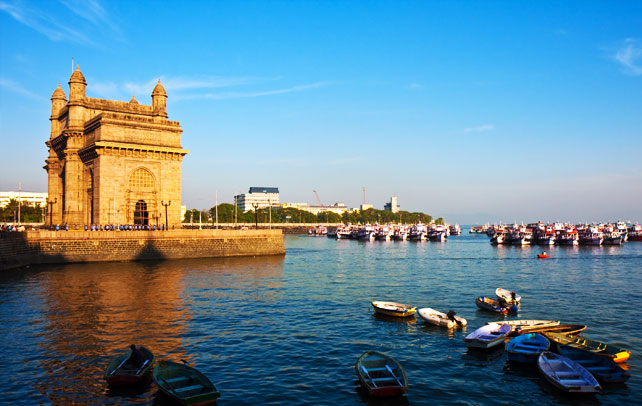Interesting Facts About Mumbai

If images could describe the spirit of a city, then the best way to describe the soul of Mumbai would be the efficient dabbawalas in their Gandhi topis, the beautiful Queen’s necklace or Marine Drive, a plate of vada pavs and now recently the chilling image of the iconic Taj Mahal Hotel engulfed in flames. There are many other images that the thought of ‘Maximum City’ can conjure up in one’s mind depending on how much you love and know the city. Mumbai (Bombay), the city of extremes, where appalling poverty goes hand in hand with ostentatious display of wealth and power, where a thin line defines chaos and order and where tradition and modernity blend seamlessly is also known as the ‘city of dreams’. Its spiraling financial success has ensured that the city is the final destination for anyone wishing to strike it big or, as in the case of the majority in this sea of humanity, just wish to make a living. The city never fails to astonish and surprise and everyday one can experience the madness that makes Mumbai so loved. To know more on this majestic city, read the interesting facts given below.
Interesting Facts About Mumbai
- Throughout its history, Mumbai was governed by many empires. It was a part of the Maurya Empire during the 3rd century B.C.E. Between the second century BCE and ninth century A.D, Mumbai came under the rule of several indigenous dynasties, such as, Satavahanas, Vakatakas, Kalachuris, Chalukyas and Rashtrakutas. During the period 810 A.D to 1260 A.D., Mumbai was ruled by the Silhara Dyanasty. By the 13th century, Mumbai was the kingdom of King Bhimdev before being annexed by the Delhi Sultanate and ruled till 1407 after which the independent Gujarat Sultanate ruled the city till 1534 when all the islands that constitute Mumbai were handed to the Portuguese Empire. In 1661, the islands came under the British Empire as a part of the marriage treaty between Charles II of England and Catherine of Braganza.
- Mumbai was originally a cluster of seven islands — Colaba, Bombay Island, Parel, Mahim, Worli, Little Colaba and Mazagoan. The islands were inhabited by the Kolis, a tribe of fisherman. The seven islands were joined together through land reclamation projects to form the city of Mumbai in 1862.
- During the 20th century, Mumbai was a strong base for the Indian Independence Movement. The first session of the Indian National Congress was held here in December 1885 and for the next 50 years, the city hosted the annual Congress session 6 times.
- The city derives its name Mumbai from the patron goddess of the Kolis—Mumba Devi. During the British rule, it was known as Bombay and the name was changed to Mumbai only recently.
- The first passenger railway line in India was launched in 1853 connecting Mumbai and Thane.
- The city saw its first economic boom during the American Civil War (1861-1865) becoming the chief cotton trading market in the world.
- In 1960, Maharashtra was formed and Mumbai was declared as the capital of the new state.
- Mumbai has the double distinction of being the most populous state in India and the fourth most populous city in the world with an approximate population of 20.5 million in the metropolitan area.
- Navi Mumbai is the world’s largest planned city with an area covering 344 square kilometers. The twin city of Mumbai was developed in 1972. The Navi Mumbai Municipal Corporation manages the city’s affairs and is the one of richest corporations in Asia.
- Mumbai is the richest city in India and is the country’s commercial and entertainment capital. It has the highest GDP among any city in South, West or Central Asia and is one of the top ten financial centers in the world.
- The iconic Gateway of India was designed by the British architect, George Wittet, to commemorate the visit of King George V and Queen Mary to Mumbai and was opened to the public in 1924. When India gained independence, the last of the British ships left the shores from the Gateway of India.
- The Haji Ali Dargah is one of the most important landmarks in Mumbai. The mosque, built over the tomb of the saint Haji Ali, is situated 500 yards into the sea and so can only be reached at low tide. During high tide, the mosque appears to be floating in the sea as the causeway leading to it is submerged.
- The famed dabbawallas of Mumbai are famous worldwide because of their efficiency, with Forbes giving them the `six-sigma rating, which means that they make about one error in six million transactions. Dabbawallas are an unique Mumbai institution feted by the high and mighty like Prince Charles.
- Spread over 535 acres, Dharavi is one of the largest slums in the world and has a population of approximately 1 million. The slum has around 5000 businesses and 15 thousand single room factories. The goods manufactured here are exported throughout the world.
- Mumbai was ranked the “Alpha world city” in 2008 by the Globalization and World Cities Study Group. The same year Forbes magazine ranked the city seventh in the list of “Top Ten Cities for Billionaires”.
- The most famous export of Mumbai is the Hindi film industry also known as Bollywood. Hindi film industry is probably the largest film industry in India. Mumbai is also the center of the Marathi film industry.









